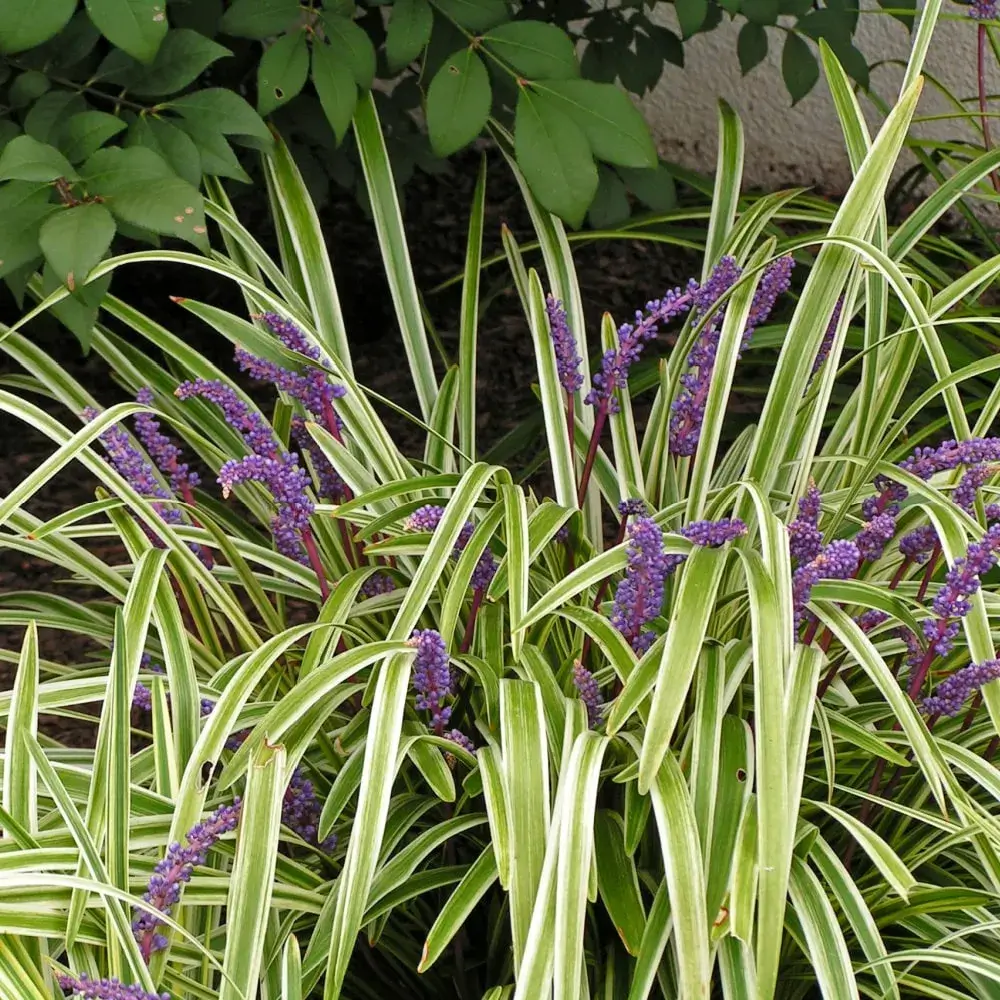Family: Lily Turf
Type: Perennial
Other Common Name: Border Grass, Lilyturf

Liriope muscari ‘Variegata’, commonly known as Variegated Lilyturf, is a perennial groundcover prized for its striking foliage. This plant features long, slender leaves with creamy white edges, adding a splash of color to the landscape.
Not only is Variegated Lilyturf visually appealing, but it’s also renowned for its hardiness and adaptability. It thrives in a range of conditions from sun to shade, making it a versatile choice for gardeners.
This variety is particularly effective in providing year-round interest. In addition to its variegated foliage, it produces small, lavender flowers in late summer, followed by dark berries in the fall.
Hardiness Zone: 4b-6a
Pet Friendly: Yes
Moisture Preference: Average to moist
Sun Needs: Partial shade to shade
Growth Rate: Fast
Average Height (feet): 1.5
Average Spread (feet): 3
Average Life Span (years): 10
Form: Spreading
Flower Color: Purple
Secondary Flower Color: Purple
Bloom Season: In late summer
Foliage Color: Green
Foliage Shape: Grassy
Incorporating Variegated Lilyturf into your garden can add both beauty and functionality. Its dense growth habit makes it an excellent choice for ground cover, erosion control, or as a lawn alternative.
This plant is ideal for borders, edging pathways, or underplanting in wooded gardens. Its variegation brings light to shady areas and contrasts beautifully with dark-leaved plants.
Despite its ornamental appearance, Variegated Lilyturf is low maintenance. It’s a great option for gardeners who want a ground cover that requires minimal care.

In contemporary gardens, Variegated Lilyturf adds a modern touch with its clean lines and striking foliage.
For woodland gardens, its adaptability to shade and natural growth habit makes it a perfect fit, adding texture and color under trees.
In coastal gardens, Variegated Lilyturf's tolerance for salt and varying conditions makes it a robust choice.
Use it as a border for garden beds. Its neat appearance and variegated leaves create a beautiful, defined edge.
Plant it in shaded areas where grass struggles. It’s an excellent alternative to traditional lawn in less sunny locations.
Combine it with other shade-loving plants. Hostas and ferns make great companions, offering a variety of textures.
Select our pre-made garden layouts to create a landscape that’s uniquely yours. Simple, smart, and customizable!
In spring, Variegated Lilyturf begins to grow, its variegated leaves adding fresh color to the garden.
During summer, it blooms with small, lavender flowers, adding a delicate touch to its striking foliage.
In the fall, the flowers give way to dark berries, while the variegated leaves continue to add interest.
In winter, Variegated Lilyturf remains evergreen in most climates, providing color and ground cover throughout the season.
Variegated Lilyturf is versatile, thriving in both sun and shade. It’s ideal for planting under trees, along borders, or in areas where grass won’t grow.
This plant adapts well to various light conditions, from full sun to full shade, but it flourishes best in partial shade.
Variegated Lilyturf prefers moist, well-draining soil. It's tolerant of a range of soil types, including clay and sandy soils.
Space plants about 12 to 18 inches apart. This allows them to form a dense mat, providing effective ground cover and weed suppression.
The best time to plant Variegated Lilyturf is in the spring or early fall, allowing the roots to establish before extreme temperatures.
Dig a hole slightly larger than the root ball. Place the plant in the hole, ensuring it’s at the same depth as in the container, backfill with soil, and water well.
Regular watering is needed, especially in dry conditions. Once established, Variegated Lilyturf is quite drought-tolerant.
Fertilize in early spring with a balanced, slow-release fertilizer to encourage healthy growth throughout the season.
Pruning is generally not necessary, but you can trim back the foliage in early spring to maintain neatness or to remove any winter-damaged leaves.
In spring, clear any debris and apply a light layer of mulch to retain moisture and suppress weeds.
During summer, water the plant as needed, especially in periods of drought, to keep the soil consistently moist.
In fall, reduce watering as the plant begins to go dormant. Remove any fallen leaves to prevent fungal diseases.
Variegated Lilyturf is generally hardy in winter. In colder regions, a layer of mulch can provide extra protection.
Variegated Lilyturf spreads moderately, forming a dense ground cover within a couple of seasons.
Yes, Variegated Lilyturf is relatively deer-resistant, making it a good choice for gardens in areas with deer activity.
Absolutely, Variegated Lilyturf can be grown in containers, adding an attractive foliage element to patios or balconies.
Sign up below to get exclusive deals, discounts, and new plant collections—delivered straight to your inbox! Plus, stay inspired with the latest gardening tips, landscaping trends, and DIY garden ideas. Start growing with us today!
A big thank you for subscribing to the PBN Design newsletter.
We're thrilled to have you join our community. Get ready for exciting updates, insightful content, and more delivered straight to your inbox.
Stay tuned!
Go backA big thank you for subscribing to the PBN Design newsletter.
We're thrilled to have you join our community. Get ready for exciting updates, insightful content, and more delivered straight to your inbox.
Stay tuned!
Go back